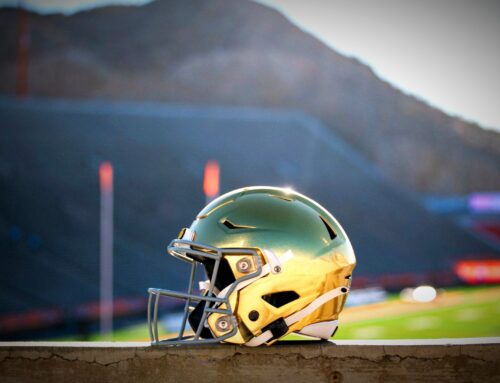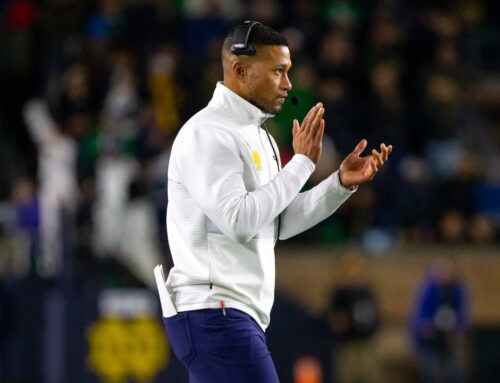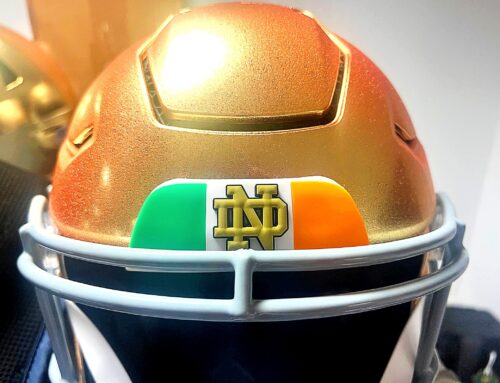As we draw closer to the start of the 2016 season, we began to reflect on the 129-year history of Notre Dame football and all the faces that have come and gone in the program. The historical roster is full of fascinating nuggets that sometimes offer the joy of discovery of random trivia, and sometimes offer surprising insight into trends and constants in the makeup of the Irish gridders.
Think Global, Act Irish
We’ll kick off our stroll down memory lane by thinking globally, which we hear is a big deal these days. You may remember that 2016 signee Chase Claypool hails from Abbotsford, British Columbia; you may also know that a number of former Irish players spent time north of the border professionally, such as Joe Theismann, Rocket Ismail, Tony Rice, Tom Clements, Frank Tripucka, Jarious Jackson, and many others.
In fact, a much greater number of Irish players have called Canada home after college than before – Claypool will be only the fifth Canadian football player in Notre Dame history (using hometown at time of enrollment because, come on, how much free time do you think I have?). The other four are Nick Doyle (Ontario, 1906), Mike Webster (Vancouver, 1963-1964), Pete Lamantia (Toronto, 1966), and Bill Mitoulas (Toronto, 1994-1997). I had a web programming class with Bill Mitoulas, which is the beginning and end of what I can tell you about him. Other than that he’s from Toronto, of course.
The dearth of friendly northern neighbors was perhaps the biggest surprise to me as I went through the roster. Toronto, for example, is about the same distance from South Bend as Nashville, and is closer than Philadelphia, New York, Boston, Baltimore, Washington DC, Atlanta, Memphis…well, you get the point. Five players in 129 years. Weird.
Perhaps equally interesting is the fact that Nick Doyle was not the first international player in Notre Dame history, as well as the fact that our first international player therefore wasn’t from Canada. I’ve given you a minute to collect yourselves…that honor goes to none other than Jenaro Davila, an end on the 1895 team who hailed from Monterrey, Mexico, which is about 1,100 miles farther away from South Bend than Toronto. In addition to being the first and only Mexican football player for Notre Dame, he was a multi-sport athlete, as documented in this Notre Dame archives article about the boat club. The article includes a great image of one of the 1896 boat crews; Davila is in the front row, second from the left.
Believe it or not, in 129 years of history, there has only been one other international player for the Irish, and even that is stretching it a bit. Kicker Jude Rhodes walked on to the team in 2012; he was born in Mississippi but essentially grew up in Kenya, where his parents did missionary work. He played some high school ball in California but, in his lone year of football participation, is recorded in the Irish annals as being from Kenya.
That’s a grand total of six players (or five, depending on how you look at it) who have played for the Irish and had a primary address in a foreign country while doing so. Surprising, right?
The Domestic Roster
Moving inside our borders now, we’ll look at the domestic makeup of the roster. A stroll through a sporting goods store in just about any town in the country, a quick scan of the alumni club list, or a sharp ear for the multitude of regional accents in the tailgate lots will let you know that Notre Dame draws students and fans from all over the United States. What’s fun to see as you look through the historical roster is, believe it not, that has always been the case.
To wit: The program’s first-ever team, in 1887, featured 14 players from 13 states – Georgia, Iowa, Illinois, Kentucky, Louisiana, Michigan, Minnesota, Missouri, Nebraska, Ohio, Oregon, Texas, and Washington (Minnesota was the one repeat, if you’re curious). The lone Michigander on that first squad was quarterback George Cartier, as in the younger brother of William Cartier, as in the guy who paid for Cartier Field. Notably absent from that state list? Indiana. In fact, the Irish football program wouldn’t claim its first Hoosier until its third year of activity, in 1889. After a brief gap the roster once again dipped into Indiana in 1892 and has every year since, aside from 1928, 1929, 1953, and 2001.
One of those early Hoosiers, incidentally, was Charles Niezer (1897); if you followed the link to the boat club picture above, you may recognize him as a crewmate of Jenaro Davila. Boom.
Speaking of states…the state that has seen the most players suit up for the Irish is Illinois, which with 472 players can claim roughly 16% of Notre Dame’s historical roster. The rest of the top five, in order, are Ohio (332), Indiana (243), Pennsylvania (218), and California (149). If you’re wondering where the other non-Midwest recruiting hotbeds check in, Texas (108) is ninth and Florida (87) is 12th.
While the international roll is thin, as noted, the domestic roll is comprehensive – all fifty states plus the District of Columbia are represented in the historical roster. Alaska and Vermont bring up the rear with one player each – right halfback Lee Matthews, 1908-1910, from the Frontier State, and fullback Tom Listzwan, 1928, from the Green Mountain State. Among the less-populous states, Montana stands out by virtue of the nine players it has sent to South Bend, beginning with guard Anson Bennett in 1898 continuing most recently with linebacker Pat Ryan from 2000-2002. The Aloha State, one would assume by coincidence, has also sent nine players total, with Manti Te’o and Reggie Ho being the most notable.
From what one might reasonably consider the Deepest South–Alabama and Mississippi–the Irish program has pulled a total of 15 players in its 127-year history – nine from Alabama, and six from Mississippi. This aligns with the common perception that Notre Dame has a very difficult time recruiting in these states, for reasons both too numerous and too nebulous to go into here. If you’re the optimistic sort, you might note that 10 of those 15 players have suited up in the last 25 years, so the rate has drastically increased. From zero to…something. Woot, woot. The most substantial contributors by far from each state were Jarious Jackson (Tupelo, MS) and Justin Tuck (Kellyton, AL).




